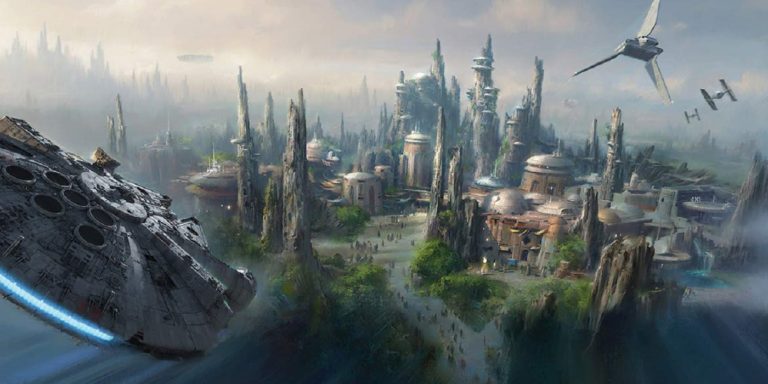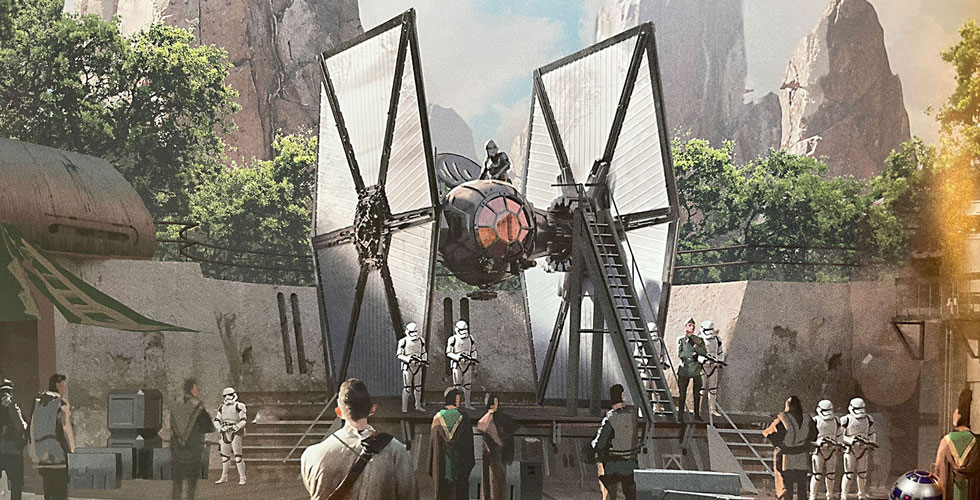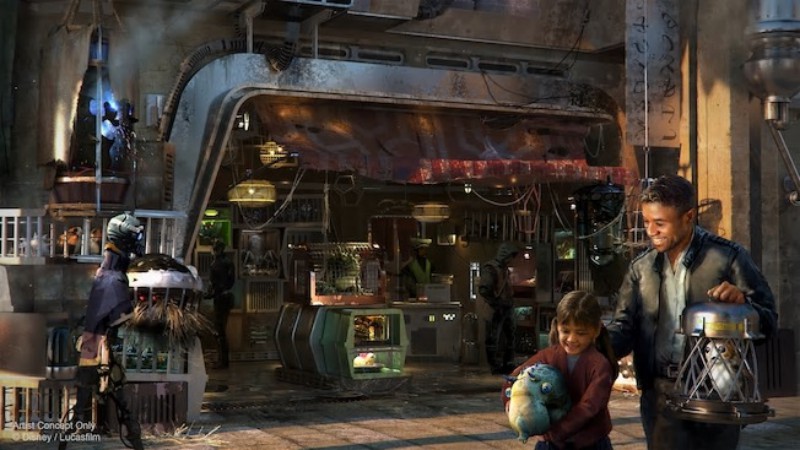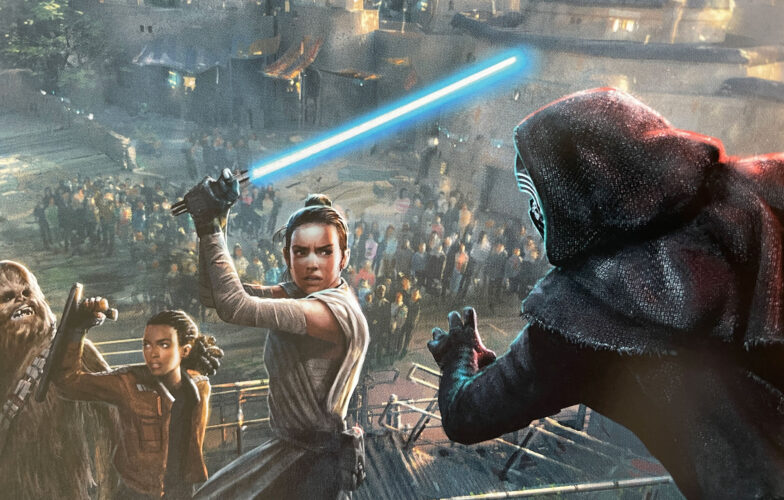When Disney officially announced that it was moving forward with the long-anticipated creation of a fully immersive Star Wars land in 2015, it felt like the company might’ve finally found its “Potter Swatter.”
Though Disney had certainly played around with the “Living Land” formula invented by Universal’s Wizarding World of Harry Potter in 2010, Star Wars: Galaxy’s Edge would be the genre’s height: a land so immersive, so authentic, and so committed to thrusting guests into the Star Wars universe that it would make Hogsmeade look like a county fair.
At a reported cost of around a billion dollars each, the two copies of Galaxy’s Edge (at Disneyland and Disney’s Hollywood Studios) were indeed on a scale never seen before. All-encompassing. “In-universe.” No music. No meet-and-greets. Literally part of the heavily-studied, academic, official Star Wars canon, with its events tethered to a single day on the centuries-spanning timeline. The problem is… well… it didn’t necessarily land.
There are countless reasons why the Star Wars: Galaxy’s Edge that we got didn’t quite resonate the way Disney hoped. Let’s list a few of the major ones…
The Issues
1. The Place

Some fans take issue with the idea that – even if for good reason – Galaxy’s Edge doesn’t bring to life a place we’ve “seen on screen,” immediately losing some of the wish-fulfillment that comes from Hogsmeade, Diagon Alley, or Cars Land. Instead, it’s set (by necessity of the limitations of a theme park) on a new planet whose existence has been backwards-engineered into Star Wars canon, but never included in a film or television show.
Look, we know it’s not possible or practical for Disney to have recreated a planet we’ve already seen. In all of Star Wars canon, few places are inherently “theme-park-able” in the sense that they’re important, but have bathrooms; habitable, but with ways to hide show buildings.
Since Disney’s messaging around Galaxy’s Edge is all about inviting you to “Live Your Own Star Wars Adventure,” it’s not such a bad thing that Batuu is a planet we don’t necessarily know, especially since by any measure, Imagineers did a good job making it “feel” like Star Wars. But it’s certainly a sticking point.
2. The Timeline

You have to remember that Disney only acquired Lucasfilm in 2012. To be ready to announce a fully fleshed-out billion dollar theme park land based on the franchise three years later shows just what a priority it was for the company. But you can also see why – at that early vantage point – it made sense for Disney to embrace the boundless future of Star Wars. Sure, the original trilogy (the world of Luke Skywalker, Princess Leia, Han Solo, and Darth Vader) would always be the roots of Star Wars…
But given the universal critical and commercial praise for the first entry in Disney’s sequel trilogy – 2015’s The Force Awakens – the future of Star Wars looked not just bright, but boundless. Setting a Star Wars land in the timeline of Rey, Poe, Finn, and Kylo Ren not only served to promote the in-production “sequel trilogy,” but the countless projects that would no doubt ripple out from its “rebooted” world.
Of course, in 2024, we can see that Disney’s sequel trilogy… well… it sort of petered out, with its two subsequent entries each declining in critical and commercial measures.
To make matters worse, three things happened in 2019: Star Wars: Galaxy’s Edge opened, the sequel trilogy’s final entry – The Rise of Skywalker – bombed, and the Disney+ Original Series The Mandalorian indicated to Disney’s chagrin that perhaps the future of Star Wars was more properly in the past… To rub salt in the wound, as “Baby Yoda” merchandise became the must-have of the 2019 holiday season, Disney found itself with two billion dollar Star Wars lands that weren’t allowed to sell it… Why?
3. The Exhaustive Realism

Unfortunately for Disney Consumer Products, The Mandalorian is set during the series’ “original trilogy,” decades before the locked-in timeline of Galaxy’s Edge. So even as Disney could’ve made millions from “Baby Yoda” plush, merchandise with the character was instead exiled to a cart just outside of the land.
Maybe fans should’ve been proud of that commitment. After all, fans cite it as a point of pride that Universal’s Wizarding World doesn’t sell Coca-Cola, LEGO sets, or DVDs and instead insists on “real,” “in-univese” souvenirs and foods.
Disney took that high water mark and decided to go even further. The problem is, their commitment to showing how “real” they could make Galaxy’s Edge probably went a little too far. The land famously doesn’t play even a custom composition of Star Wars‘ iconic score. Instead, it’s “scored” only by the sounds of arriving and departing ships and other environmental noises. Though you might want to meet Darth Vader, you can’t. He’s been dead for years. And besides, why would he come to some nowhere planet at the farthest corner of the Outer Rim?
Disney Imagineers also cooked up a cockamamie “lingo” for the land where the planet’s alien residents welcome you with “Bright suns” instead of hello, and “‘Til the spire” instead of goodbye. It’s cute… until you ask a Cast Member where the bathroom is and they pretend they don’t have a clue what you’re talking about. (It’s a “refresher”.) When’s the parade? Never heard of it. Fireworks? What fireworks? While Cast Members do their best to balance courtesy and show, it all goes to show that “total immersion” might sound good on paper, but isn’t necessarily what guests actually want.
4. The Lack of Action

One of the key selling points of Galaxy’s Edge when it was announced is that this land would be brimming with action and entertainment. Disney’s marketing promised extravagant secret clubs and dinner shows; giant animatronic beasts and “real” Droids roaming freely around the land; alien shopkeepers that would see even small kiosks staffed not by operations Cast Members, but by union entertainers; drones serving as ships that would land and depart from Batuu all day and night; and of course, action, with literal stages built to host battles, fight scenes, and stunt shows that would criss-cross the village’s rooftops in laser battles, Lightsaber fights, and more every day.
Famously, those all… well… failed to materialize. Let’s just say that fans blame the appointment of infamous penny-pincher Bob Chapek to the Parks, Experiences, and Products Chairman position in 2015. Rumors insist that the miserly Chapek (known for seeking optimization and cost-savings in his data-oriented approach to the parks) immediately slashed the land’s entertainment budget, leaving it… well… dull. There’s almost no kinetic energy; no action; no Droids; no battles.
But now, at long last, Disney is started to get some serious work done to make Galaxy’s Edge a more flexible, fan-serving, and maybe even fun place to visit. We’ll explore how on the next page…


